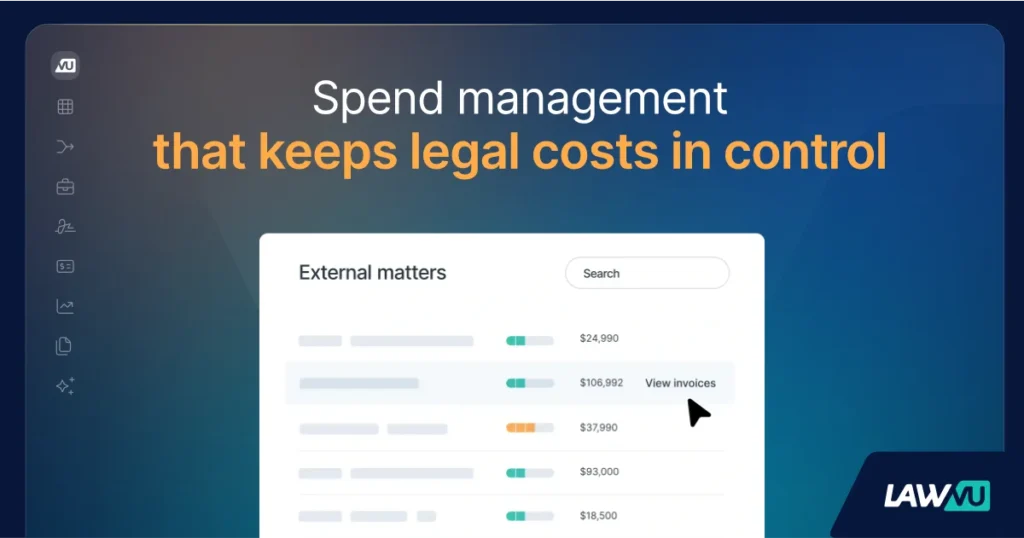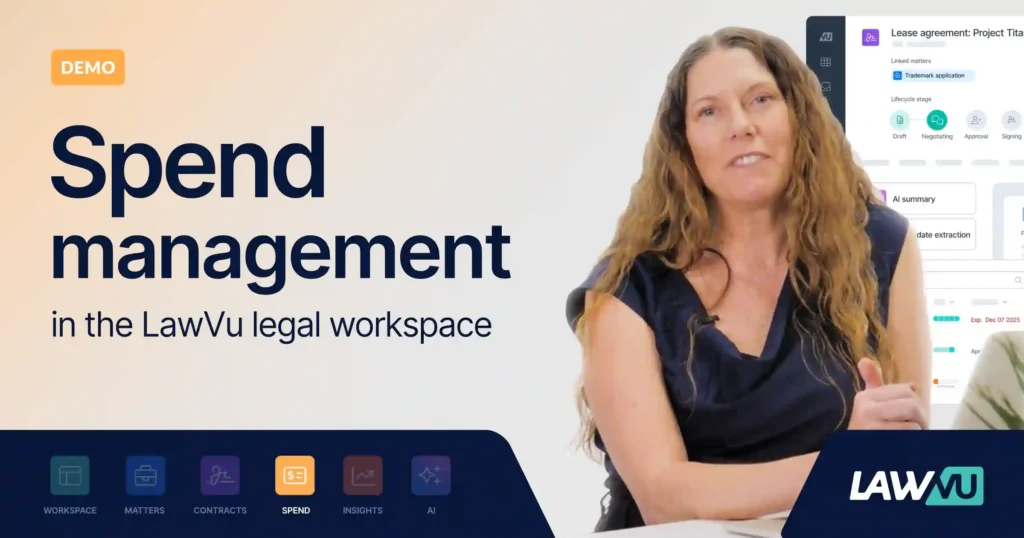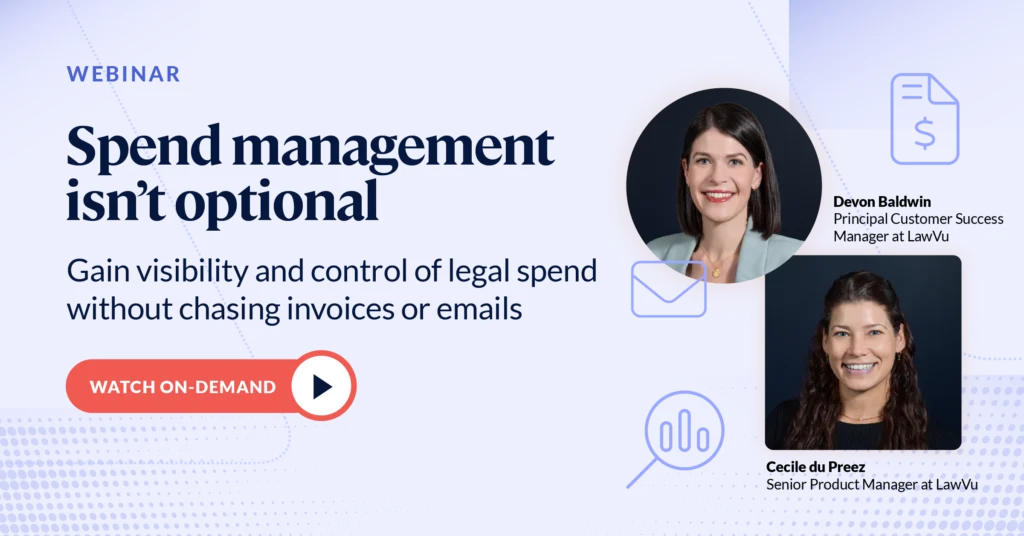Take control of legal spend: 7 ways to unlock legal spend analytics & insights with LawVu
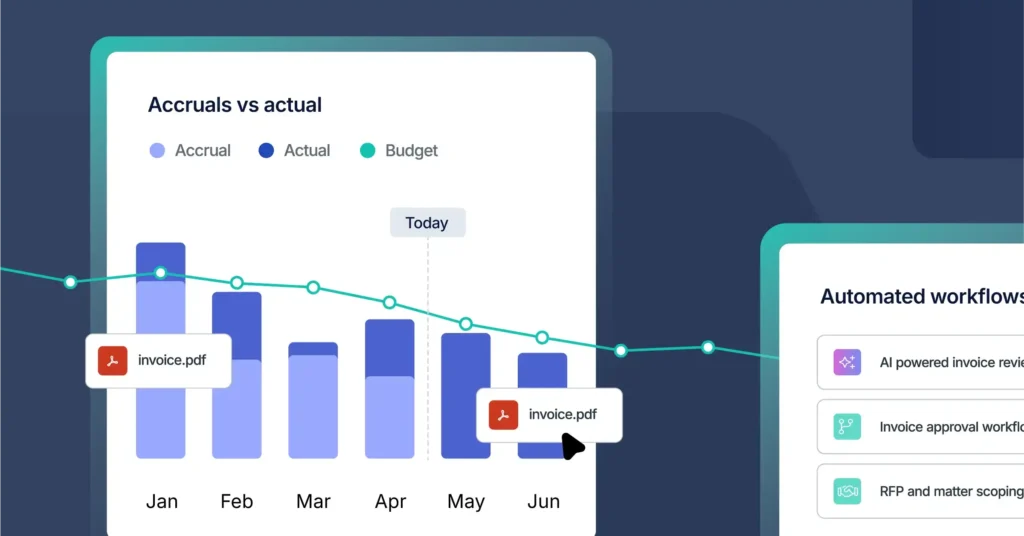
For most corporate legal teams, working with outside counsel is essential to getting legal work done and delivering value to the business.
That’s why it’s no surprise that outside counsel spend is one of the biggest line items in a legal department’s budget – accounting for around 50%, according to the latest ACC benchmarking survey. It also explains why legal spend management and e-billing software are top of mind for teams focused on improving operations, spend visibility and budgeting accuracy.
In this article, we explore how legal technology – specifically legal spend management and e-billing tools like LawVu – helps in-house legal teams become more data-driven, using legal spend analytics to unlock legal spend insights and improve operational performance.
Because when you understand exactly where money is being spent, you gain the visibility needed to control costs, optimize resources, and align legal efforts with broader business goals.
Key terms: Legal spend management, legal spend analytics and KPIs
Before we start, let’s level set on three key concepts:
Legal spend management
Legal spend management is the process of tracking, controlling, and analyzing the amount a legal department spends – especially on outside counsel and legal vendors – to ensure budgets are followed, costs are optimized, and resources are used effectively.
Legal spend analytics
Legal spend analytics refers to the use of data to understand, measure, and improve how a legal department spends money – especially with outside counsel. It turns billing and matter data into actionable insights.
Legal spend KPIs (Key Performance Indicators)
Legal spend KPIs are specific metrics businesses and legal teams can use to track performance, gauge progress and get insights to make better decisions involving legal spend. In summary, having access to and monitoring legal spend analytics is valuable for two reasons:
Firstly, understanding where money is spent gives legal leaders and legal operations visibility into a key cost center for the business. And secondly, that visibility creates opportunities to identify cost-savings, optimize resource allocation, and ensure alignment with overall financial goals.
The common roadblock to achieving better legal spend management
Despite the clear value of legal spend analytics, many in-house legal teams still face roadblocks when it comes to managing spend effectively. Fragmented systems, unstructured data and manual processes make it difficult, if not impossible, to gain clear pictures of spend. Without reliable, centralized data, setting and tracking legal spend KPIs or making informed, strategic decisions around legal spend and budgeting can easily become a major hurdle.
If you’re unsure where your legal team stands on the spend management maturity curve, this resource will help you assess your current approach – and determine whether it’s time to rethink how you manage legal spend and e-billing.
The key to unlocking legal spend analytics and achieving better spend management
The key to unlocking your legal spend analytics and achieving better spend management is having the right spend management software in place. Here’s how:
Centralizing legal spend and invoice data
By centralizing your legal spend and invoicing analytics in a single source of truth (e.g. your chosen spend management software), your team members can save time by reducing the manual effort associated with managing invoices and approvals previously managed via email and spreadsheets.
Additionally, once you have standardized your workflows within one central system, it becomes the single source of truth where relevant team members can easily access reports and monitor legal spend analytics – for both matters in progress and for historical views on spend data and trends over time (pictured below).
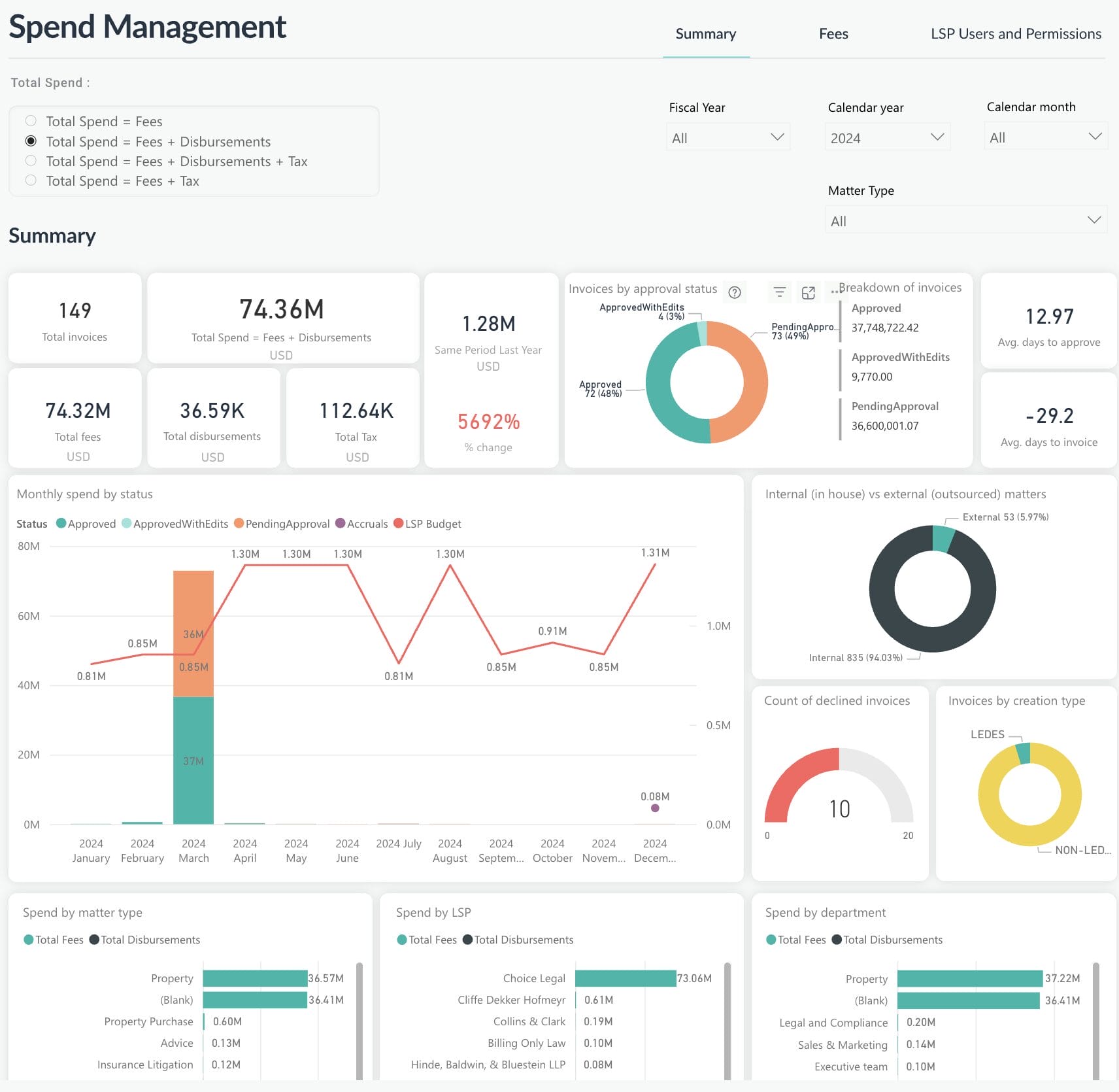
A spend management dashboard within a spend management and e–billing software like LawVu can consolidate legal spend analytics related to invoices, fees and outside counsel spend.
Automating data capture
As invoices are uploaded to the spend management software – either by your team or your law firms, key data is captured in a structured and consistent way that can be used for reporting, analytics and KPI tracking.
Some vendors even offer AI -powered data extraction, which keeps your team from doing manual data entry when a high volume of your invoices are received in a.pdf format.
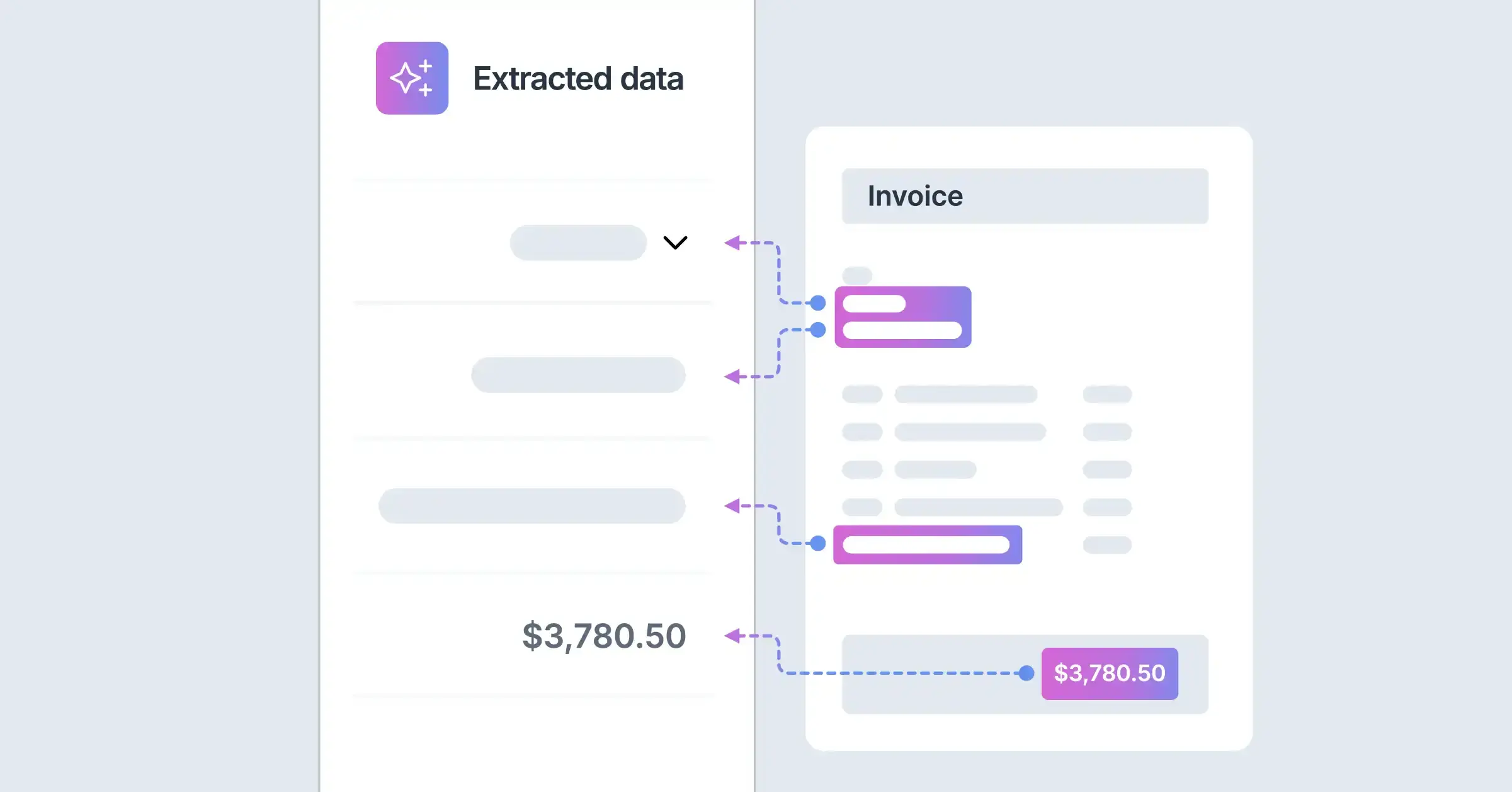
AI-powered invoice data extraction automatically extracts data from invoices into your spend management software, so it can be captured and applied to legal spend analytics and reporting.
Tracking spend against budget in real-time
Your spend management software should include features that allow you to set up budget information for individual matters and at broader levels such as monthly and annual views. This makes it possible to see and understand how you’re tracking against budgets as invoices are added to the system.
Having visibility over this information without having to put in a lot of effort will set you up for success when it comes to legal spend analytics and reporting.
Address cost concerns and showcase the value of legal
Given the level of spend on outside counsel, you should be able to communicate about your spend without barriers; with easy access to legal spend analytics, you can easily address questions, proactively prepare the business for unexpected expenses, and showcase ways in which the legal budget is being used to support business objectives.
Enable budget v actual KPIs
A simple must-have legal spend KPI for any corporate legal team communicates how often matters are completed within the approved budget or forecast and how legal spend is tracking against the budget agreed to by the business.
Regularly tracking this information helps legal prove financial stewardship and monitor progress against any intended cost control improvements.
Identify opportunities to reduce cost
In-house legal teams are often surprised with overages as matters progress and when actual spend exceeds budget projections.
While some unexpected costs are unavoidable, imagine having the legal spend analytics in real-time and the ability to intervene, for example, by finding a way to reassess priorities, renegotiate terms, or change staffing to stay on budget.
Historical legal spend analytics can also be applied to analyze where and how legal spend can get out of control. This means being able to prevent these situations from arising with strategic actions like hiring, better rate negotiations, or simply better budget planning.
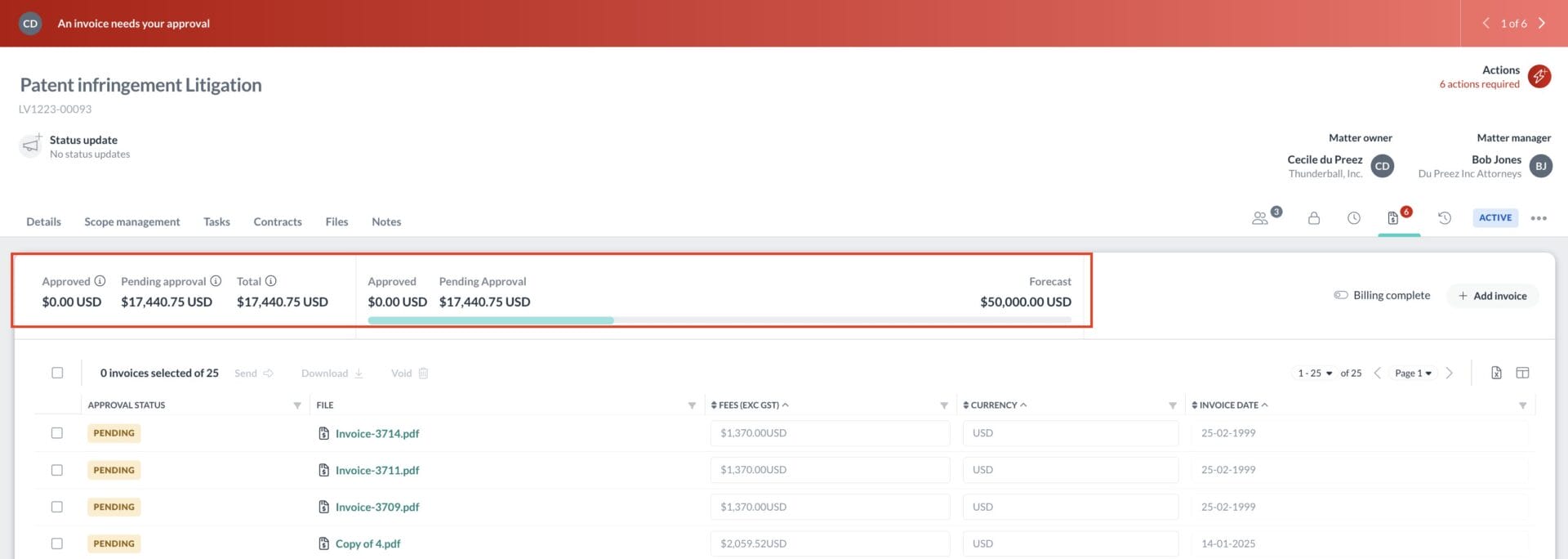
Pictured above is a snapshot view of a matter with a budget of $50,000. As invoices are uploaded and approved, you can see how the matter is tracking against what is budgeted.
Out-of-the-box reporting and dashboards
This is arguably the most important feature to evaluate when it comes to legal spend management and e-billing software. After all, legal spend analytics are not much use if it’s not easy to access, analyze or communicate.
If they’re easy-to-use and visual, with the ability to quickly slice and dice information, you’ll be able to ask and answer questions quickly, gain actionable insights, and share information with your stakeholders in formats they can easily understand.
To see an embedded spend management dashboard and legal spend reporting in action, check out this guided walkthrough of the spend management dashboard in LawVu:
Here’s an interactive tutorial
Take control of your legal spend
Legal spend remains one of the largest yet least transparent areas of legal operations. But with clear, accessible data, teams can gain the visibility they need to control costs, justify budgets and operate more strategically. That’s why having the right legal spend management and e-billing software in place enables legal teams to define, track and report on key legal spend KPIs – turning cost data into actionable insights that demonstrate legal’s value to the business.
Purpose-built legal spend management and e-billing tools make this process faster, easier, and more accurate. And for teams looking to take a more representative view of their analytics, investing in a consolidated legal workspace like LawVu unlocks more comprehensive insights – not just into spend, but across the full spectrum of legal workflows, including legal matters and contract management.
LawVu brings all this together in a single platform – giving in-house legal teams complete visibility over their legal work, spend, and impact. Book a demo today to see how LawVu can help you make smarter, data-driven decisions.
